Many members of the Kaiserslautern Military Community have found temporary or even permanent homes in one of the many villages and towns surrounding Kaiserslautern or in the heart of the Palatinate Forest.
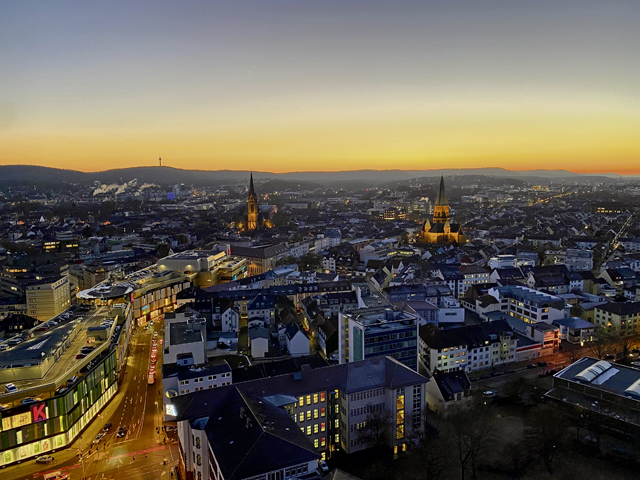
Talk of the Town is a series highlighting the union communities within the County of Kaiserslautern, the City of Kaiserslautern and the Union Community of Winnweiler in neighboring Donnersberg County. The series aims to inform American service members and their families about the communities they’re joining during their time in the KMC. Each month we will feature a different community and provide facts about its history, heritage, and the local experiences it offers.
Our next stop will lead us to the City of Kaiserslautern in the heart of the Palatinate Forest and the largest city in the Westpfalz Region (Western Palatinate). We invite you to discover interesting and maybe not so well known facts about your home away from home.
Emperor’s Lauter
The City of Kaiserslautern is divided into districts, such as Innenstadt, Grubentälchen/ Volkspark, Betzenberg, Laemmchesberg/Uniwohnstadt, Baennjerrück/Karl-Pfaff-Siedlung, Kaiserslautern-West (including Vogelweh), Erzhuetten, Erfenbach, Einsiedlerhof, Morlautern, Erlenbach, Moelschbach, Dansenberg, Hohenecken and Siegelbach.
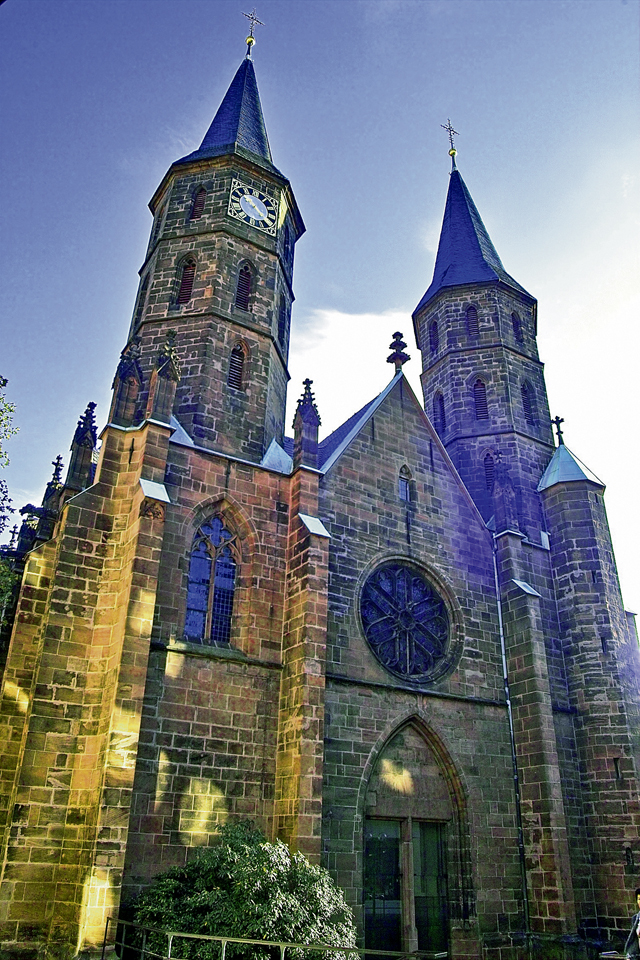
Kaiserslautern means the “emperor’s Lauter”, derived from the Latin word “Lutra” for the stream that still flows underground in the downtown area today. The city has about 102,000 inhabitants and over 1,000 military families reside on Vogelweh housing.” People of 150 different nations make up a colorful and multinational society.
Lord Mayor Dr. Klaus Weichel has been in office since 2007 and would like to extend a cordial welcome (see page 7).
Spanish, Swedes, French, Croatians and Napoleon
Kaiserslautern also looks upon a history of early settlements and international occupancy throughout the centuries. Earliest settlement traces date back to the 6th millennium B.C. Another prehistoric settlement, believed to be Celtic, has been traced to at least 800 B.C. During the Middle Ages Kaiserslautern became a royal residence when Emperor Friedrich Barbarossa erected a Kaiserpfalz. The Stiftskirche is the oldest church and was constructed in 1250-1350. King Rudolf von Habsburg chartered the town in 1276 and St. Martin’s Church was built from 1300-1350, where a section of the original city wall can still be seen in its courtyard today.
During the Thirty Year’s War (1618-1648) Spanish troops occupied the city until Swedish armies liberated the area. Later Croatian troops of the Austrian emperor seized the city and killed over 90 percent of the city’s 3,200 inhabitants. French troops then repeatedly invaded and occupied the area until it was restored as part of the Palatinate. In the 18th century French and Germans fought until the French eventually destroyed Barbarossa’s castle and the city towers. From 1793 until his defeat, Napoleon Bonaparte is said to have personally traveled the road, commonly referred to as “Kaiserstrasse” (B37/Pariser/Mainzer Strasse), leading through Kaiserslautern from Einsiedlerhof towards Mainz. In 1815 it became part of a Bavarian province and remained so until French troops occupied it again after World War I.
Studies, research and a technology hub
Kaiserslautern has two universities, the Technical University and the Hochschule (University of Applied Sciences) with 20.000 students. It is also home to the Fraunhofer Experimental Software Engineering Institute, the Fraunhofer Institute for Industrial Mathematics, the Max Planck Institute for Software Systems and the German Research Center for Artificial Intelligence. The Adam Opel automobile plant was established in 1966 and the world famous Pfaff Sewing machine company was founded in 1862.
A red beard, a fish on a red flag and little red devils
Emperor Friedrich Barbarossa partially resided in Kaiserslautern and erected a Kaiserpfalz (an emperor’s residence) from 1152 to 1160. The remains are still visible between the city hall and the main bus stop downtown. Barbarossa means “red beard” and the city is proud to use the title “Barbarossastadt” in his honor.
During the Middle Ages Kaiserslautern was surrounded by numerous ponds with an abundance of fish. Legend has it that in 1497 a giant pike that had a ring with Greek insignia was caught in the “Kaiserwoog”. It is said that Emperor Friedrich II (grandson of Barbarossa) personally put this fish in the pond 267 years earlier. Thus, the fish was integrated into the red and white city flag and coat of arms.
The players of the famous soccer team 1. FCK (Fussballclub Kaiserslautern) are often referred to as the Rote Teufel (red devils) due to their fierce battles winning the German premier league four times. Fritz Walter, an early heroic member of the team, was the team captain of the World Cup winning 1954 German National Team and is one of Germany´s most legendary players in the history of the sport.
Fountains, towers and colorful flowers
The city has a wide spread pedestrian area and most of its attractions can be visited on foot. The Kaiserbrunnen (emperor’s fountain) at Mainzer Tor on the north-eastern end, depicts the city’s history with a myriad of bronze sculptures including Friedrich Barbarossa, Rudolf von Habsburg, a soccer ball, an automobile engine and even a boat full of dreams, along with other surprises.
Just a two-minute walk away, you may want to visit the Theodor Zink Museum, which was originally an inn for travelers, and displays historic artefacts of the life and times in medieval Kaiserslautern as well as a model of the town. The walk will lead you through Steinstrasse, the hotspot for nightlife in the 1950’s and 60’s until it was finally declared off-limits for military personnel. In the meantime, many buildings have been renovated and re-opened for evening fun. The artistic fountain at St. Martin’s Platz is nowadays a highly frequented spot to enjoy a fresh beer or a glass of wine amid pubs, restaurants and bars in historic semi-timbered buildings.
Crossing the street, your walk will lead you to Stiftskirche and historic Adler Apotheke (pharmacy). Taking a right, you will pass by Kaiserslautern’s oldest semi-timbered wine and beer restaurant “Spinnrädl”, built in the 16th century, and eventually arrive at the newly designed Schiller Platz across the street from Fruchthalle, the city´s concert hall. The complete inner city provides shopping and dining opportunities to suit everyone’s taste.
Nature lovers may want to take a hike to Humberg Turm (tower) towering over the Palatinate Forest or just visit the prominent City Hall. It was completed in 1968 and at that time was the highest city hall in Germany. Restaurant “21” is located on the 21st floor and offers a spectacular view of the city, with the “fortress Betzenberg” (Fritz-Walter Stadium) and the highest building in town, the Apostel Church with its impressive steeple.
The Japanese Garden is right across the street and is especially beautiful in the spring when the trees are in full bloom. There is also an original tea house and a large pool with koi fish.
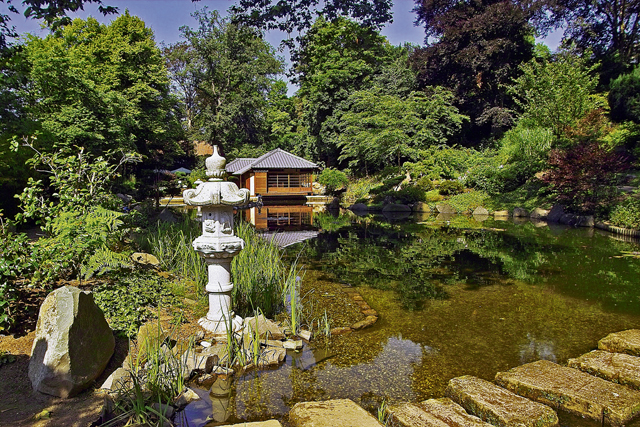
Further down the road, the Gartenschau Park, which has attracted thousands of visitors each year since its opening in 2000, boasts a life-size dinosaur display, a skater park, playgrounds and picnic areas, a picturesque chapel made of out willow branches and colorful flower arrangements throughout the year. You may even dip your feet into the cool water of the uncovered Lauter River just beneath the old sandstone quarry.
Unexpected treasures, migrants and music galore
During excavation work for an underground garage, a Jewish mikveh was discovered. At Synagogen Platz, two wall fragments of the synagogue, which was dismantled in 1938, are a memorial of the beauty of the structure, while seven 3D visual devices allow visitors to take a look at the former interior. In addition, there are three mosques and an Islamic cultural center in the city. The Institute for Palatine History and Folklife Studies has dedicated itself to history with a focus on the countless thousands from the region that emigrated to the U.S. centuries ago, full of dreams of a prosperous new life.
There are many other exciting things to do and discover in “K-town”. The zoo in Siegelbach has animals from around the world and the Wildpark in the city’s east will acquaint you with local and (almost) distinct animals. Gelterswoog offers aqua fun with a beach and water sports.
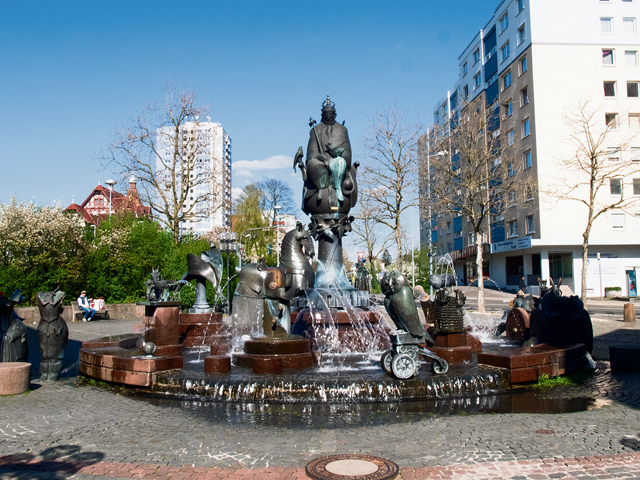
Kammgarn cultural center, a former spinning mill, has a wide selection of musical entertainment and the Pfalztheater offers concerts, plays, musicals and operas. The Fruchthalle, originally intended as a farmers’ market, has a magnificent concert hall on the third floor. The annual friendship concerts by the USAREUR and USAFE Bands also take place there.
Varying festivals occur throughout the year, such as the “Summer Nights” in July, “Swinging Lautern” in early September and the Christmas Markets during the holiday season. Twice a year the Messeplatz is host to the “Maikerwe” and “Oktoberkerwe” (fairs) with fun and rides, gastronomic delights and music in the fest tents.
Did you know that…
Kaiserslautern has two U.S. twin cities? Davenport, Iowa and Columbia, South Carolina.
Emperor Friedrich Barbarossa was rather adventurous, traveled throughout all of (today’s) Germany and drowned in Saleph River (Turkey) on his return trip from his second crusade at nearly 70 years of age?
In the 1800s a horse-drawn carriage trip from Mainz to Kaiserslautern (about 60 km) was a day’s journey?
Many Germans refer to Kleber Kaserne as “23. Kaserne”? It was built for the Royal Bavarian 23rd Infantry Regiment in 1913 and still boasts a picturesque bell tower.
Kaiserslautern was the smallest of 12 cities hosting the FIFA 2006 World Cup in Germany? The U.S. team tied against Italy in a match at Fritz-Walter-Stadium with hundreds of KMC members cheering it on.
Welcome to Kaiserslautern
As one of the largest American military bases outside of the United States, Kaiserslautern can look back on decades of excellent German-American relations. When I say relationships, I don’t just mean good neighbors.
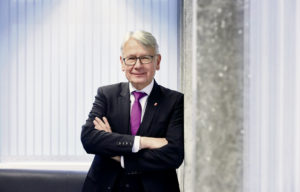 In the roughly 70 years that the U.S. Armed Forces have been on site here, many deep friendships have developed and many families have been founded.
In the roughly 70 years that the U.S. Armed Forces have been on site here, many deep friendships have developed and many families have been founded.
Germany and the United States have grown together here in the West Palatinate in a wonderful way that characterizes the region and possibly makes it unique nationwide. Anyone who hears the name Kaiserslautern thinks of 1. FCK, they think of Pfaff Sewing machines and they think of Americans. The German-American friendship and our great partnership on many levels are well-known, not only in this area but also in the U.S.
During the last decades the city has enormously changed. Kaiserslautern has evolved into an international city, a worldwide known location for science and for modern economy, especially in the high-tech sector. Nowadays, people from about 150 nations enjoy living in Kaiserslautern.
Kaiserslautern is a city on the move, which at the same time preserves its tradition. This unique mixture is what makes us special. Big, but not too big.
Both modern and traditional. A city with character, flair and heart.
I cordially invite you to visit our city.
Dr. Klaus Weichel, Lord Mayor
For further information about Kaiserslautern, please visit https://www.kaiserslautern.de/index.html.en.


